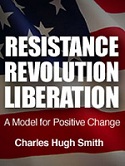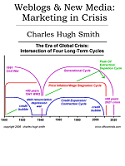

|

|
|||||||||||||
|
Thoughts on the Recent Tragedy (December 24, 2012) There are no easy solutions, there are only costs, risks and trade-offs. At least one reader was upset that I recently chose to write about the stock market rather than the tragedy of December 14. I chose not to address the mass murder out of respect for the families of those whose lives were taken. I did not want to exploit the tragedy in pursuit of visibility or an agenda; my thoughts were solely on the families of those lost. For it was not just the lives of the murdered which were taken; the families have been robbed of everything they held dear and irreplaceable. I have no agenda or pontification to push here. Other readers asked me to address the tragedy and in response to those requests I am doing so with great reluctance. These are my thoughts, and I do not claim they represent a "solution" or even an organized response. 1. Analyzing the particulars of this mentally ill gunman does not necessarily lead to valid generalizations. I have lived long enough to see mass murders of many types: snipers who killed dozens within a short time, snipers who killed singly at random, snipers who shot into passing vehicles, killers who set off bombs--the list is drearily long. After the fact, those seeking generalizations that cover all the killers can find their generalizations; but before the fact, generalizations have limited predictive value. The human mind is a complex, easily destabilized instrument; a great many people suffer from serious mental illnesses. Estimates are all over the map, but let's say 1% of the human populace suffers from serious mental illness: psychosis, schizophrenia, etc. Given that there are roughly 250 million adults in the U.S., then this 1% represents a population of 2.5 million severely mentally ill people. The number of severely mentally disturbed people who become mass murderers is a small number. Are any generalizations capable of identifying the relative handful of troubled individuals who might become mass murderers out of 2.5 million people? If we cast a wider net, this number might easily be 7.5 million people, i.e. 3% of the adult populace. The point is that identifying a handful of potential mass murderers among millions of people requires 100% "total awareness," i.e. a profile of every mentally ill/disturbed person. 2. This is the conclusion reached by the National Security State with regards to stopping terrorism: monitoring 99% of all emails and transactions isn't good enough, because the 1% that slips through is still an enormous number. This is the logic behind the "total awareness" goal of logging and scanning 100% of all emails, phone calls and transactions, and then using advanced computing to seek patterns in the resulting deluge of data. Anything less is in a sense irresponsible because it is so visibly prone to failure. 3. Mass murderers do not choose to face trained, heavily armed people in body armor; they choose to slaughter unarmed, unprepared people. When trained opponents arrive, the killers typically kill themselves or surrender. Hardening is a relative concept. Tragically, we have seen mass murder commited on military bases and the entrance to the CIA, sites that might be assumed to be hardened. Clearly they weren't hardened enough against those presumed safe, i.e. those in uniform or with I.D. This suggests that hardening potential targets simply forces the killer to locate a softer target. Once again this logic forces us to harden 100% of all potential targets because the 1% that are left unhardened will be the natural choice of the deranged but observant killer. Or the killer can follow the multitude of other killers and kill vulnerable individuals one at a time. 4. Hardening targets is not as straightforward as we might initially imagine. Let's take aircraft hijacking as a example. If you place one guard on the plane, that guard becomes the first target of the hijacker, who will have the advantages of surprise and advanced planning. Suppose instead that all able-bodied and psychologically "normal" citizens were required to undergo paramilitary training for at least 90 days and thereafter to carry concealed firearms in public. Every airline flight would largely consist of armed and reasonably well-trained adults. This would make hijacking a very hazardous method of mass killing. The point is obvious: to truly harden a public target, the only robust solution is to decentralize security so thoroughly that the would-be killer cannot formulate a way to neutralize all potentially deadly opposition. That said, it wouldn't take much for those bent on mass murder to set hijacking aside in favor of a shoulder-launched missile aimed at fully fueled taxiing aircraft from a safe distance, or sneaking a bomb into the unsecure ticketing area, or even into the crowded room of people waiting to get through security. In other words, hardening targets in public life to some degree simply drives potential killers to exploit remaining weaknesses. It is essentially impossible to harden our thousands of miles of borders with 100% certainty that no one could sneak a shoulder-launched missile into the country, or that a sniper couldn't make use of a tower or forest or any number of other places with ample fields of fire to kill people. The logic of 100% "total awareness" and hardening every aspect of public life is powerful, as is decentralizing security such that any average citizen could resist or stop a determined or deranged killer. But 100% awareness and hardening requires a sacrifice of rights and treasure. Nothing is free in life; everything requires trade-offs. Is it worth it? That is the purpose of democracy, to enable those who will pay the price privy to the decisionmaking. 5. A large number of physicians and nurses read oftwominds.com. I have never heard any of them say that the nation squanders enormous assets on mental health. What I do hear is that mental health is given short shrift despite the staggering 18% of GDP we spend on healthcare. 6. Law enforcement can only act after the fact, i.e. a law has been broken and evidence supports an arrest. The U.S. treasures individual rights such that a deranged person can generally only be held for 24 hours, and only then if he is deemed to pose an immediate danger to himself or others. Primary care doctors who treat severely mentally disturbed people in emergency rooms often have few resources to refer these individuals to for further treatment. That tens of thousands of mentally ill people "fall through the cracks" of our complex and costly healthcare system is obvious to anyone who walks around any urban center of any American metropolis. 7. The mainstream media (not a non-profit or disinterested enterprise) and social media play key roles in publicizing "successful" attacks; the frenzy of global coverage makes "copycatting" attractive. Rather than get into a dead-end discussion of "freedom of the press," (we cannot control social media, etc.) I think the point is to acknowledge that sensationalizing "if it bleeds, it leads" has a cost that though difficult to quantify is still a cost. To claim otherwise is to be in denial of the obvious. Once again, there are trade-offs. Everyone participating in sensationalizing mass murder is complicit in this cost. 8. Does the culture and society of America generate a higher rate of mass murderers than other societies? If this is a statistically valid conclusion (and I have no idea if it is or not), then what sort of inferences can be drawn from this? If data does not support this conclusion, then what inferences can be drawn from that? Or are there as many attacks on innocent people per 1,000 residents (per capita) in other nations, but attacks in America are deadlier due to relatively easy access to firearms, ammo and body armor? (It is obvious deranged killers are adept at hardening themselves against opposition with body armor. Hardening is not exclusively available to the protectors.) Or does the ineffective patchwork of mental health services in America enable a larger number of troubled mentally ill people to pass through weak social and medical filters and gain access to the means of mass murder? This seems to be a possibility that could be supported by data. If we follow the logic of "total awareness," then the best available solution to mass killing sprees might well be 100% compulsory universal national service and a universal mental health system that requires every school child (even home-schooled children) to have annual physical and mental examinations from the age of 12 on and to receive appropriate medical care and treatment, and to enter compulsory national service at the age of 18 for two years. There would be no exceptions, except for those institutionalized for severe disabilities. Those of sound mind confined to wheelchairs, for example, would still be required to serve the nation in some capacity that recognizes their limited mobility as a restriction but not one that precludes their service. There can be no exclusions, of course, because some mentally disturbed persons could game the system to escape detection. Remember the logic of "total awareness": it only works if 100% of the populace is screened and provided treatment and the data on their care is made available on a national scale. Universal service would expose every resident to the eyes and ears of their peers and supervisors. The severely mentally disturbed person would be highly unlikely to pass through such a diffused, decentralized filter unnoticed and untreated. If the goal is to treat those who need care, to serve their own interests and those of society at large, is there any other way to do so other than compulsory universal care? If universal national service included military training, administering first aid, and other critically important skills, then the "hardening" of society would move beyond first-responders and law enforcement to the society as a whole. This is the logic of decentralization, hardening, "total awareness" and "total care." Alternatively, we accept that our patchwork, underfunded mental health system will be unable to identify those who are at risk of becoming mass murderers and that half-measures of increasing security via centralized policies will leave plenty of soft targets available. Consider these points for context. We accept roughly 12,500 murders and 32,300 people killed in vehicle accidents annually without much media attention or pundit hand-wringing. That is 450,000 deaths per decade. Many of the murders (perhaps a third) are drug-dealing related, and thus they might be stopped by the legalization and official controlled distribution of currently illegal drugs. At least a third of the vehicle accidents involve alcohol, and perhaps more restrictive DUI laws similar to those in Europe would save many if not most of these 10,000+ lives lost to alcohol-impaired drivers annually. Many children lose their lives due to drunk drivers every year; are these innocent lives lost not worthy of our attention? How do we accept all these deaths as "unavoidable" when clearly more could be done within our current system? We accept 150,000 deaths a decade as a direct result of our drug laws covering both legal and illegal drugs. Little fuss is made about these 150,000 deaths that appear to be largely preventable by easily implemented measures. Let me end with an example from my personal experience. In Japan, the local police do house-to-house checks so they know exactly who is living in every dwelling in their locale. This is a form of "total awareness." Japan remains a democracy, but one with different social values: in Japan, the rights of society to be protected from individuals exceed the rights of individuals. This is the social contract. But even this "total awareness" isn't perfect. Fugitives have evaded detection for years by changing their identities, and there are now people living beneath bridges and underpasses who may not be known to the local police. None of the above should be taken as recommendations or proposed solutions. The point being made is that if the current social contract is left as is, mass murders will continue to occur based on the inputs to the system: plentiful soft targets and the means to commit mass murder and a fragmented, patchwork mental health system. Centralized government can never "harden" a society; very quickly, marginal returns set in. The only way to harden a society is to transform it into a latter-day Sparta where every citizen is a trained guardian of the social order. The only way to transform mental healthcare is to make it universal. This would require a reworking of the social contract on multiple fronts, in ways many would find counter to their stated values. We accept tens of thousands of needless deaths as "unavoidable" without really applying logic and data to this presumption. If we follow data and logic, we quickly reach much different conclusions. Right now, universal healthcare (including mental health services and screening) is anathema, despite the fact that the benefits of "total care" would be immediate and transformative. Since this alternative is unacceptable, the inputs and structure of the current social contract will remain unchanged, and so the output will also be unchanged.
If we are serious about preventing tragedies of this type, we need to examine our entire social contract and the trade-offs we are making.
There are no easy solutions, there are only costs, risks and trade-offs.
My new book Why Things Are Falling Apart and What We Can Do About It is now available in print and Kindle editions--10% to 20% discounts.
Things are falling apart--that is obvious. But why are they falling
apart? The reasons are complex and global. Our economy and society have structural
problems that cannot be solved by adding debt to debt. We are becoming poorer, not
just from financial over-reach, but from fundamental forces that are not easy to identify
or understand. We will cover the five core reasons why things are falling apart:
 1. Debt and financialization
1. Debt and financialization
2. Crony capitalism and the elimination of accountability 3. Diminishing returns 4. Centralization 5. Technological, financial and demographic changes in our economy Complex systems weakened by diminishing returns collapse under their own weight and are replaced by systems that are simpler, faster and affordable. If we cling to the old ways, our system will disintegrate. If we want sustainable prosperity rather than collapse, we must embrace a new model that is Decentralized, Adaptive, Transparent and Accountable (DATA).
We are not powerless. Not accepting responsibility and being powerless are two sides of
the same coin: once we accept responsibility, we become powerful.
To receive a 20% discount
on the print edition: $19.20 (retail $24), follow the link, open a Createspace account and enter
discount code SJRGPLAB. (This is the only way I can offer a discount.)




Please click on a book cover to read sample chapters
NOTE: gifts/contributions are acknowledged in the order received. Your name and email remain confidential and will not be given to any other individual, company or agency.
"This guy is THE leading visionary on reality.
He routinely discusses things which no one else has talked about, yet,
turn out to be quite relevant months later."
Or send him coins, stamps or quatloos via mail--please request P.O. Box address. Subscribers ($5/mo) and contributors of $50 or more this year will receive a weekly email of exclusive (though not necessarily coherent) musings and amusings. At readers' request, there is also a $10/month option. What subscribers are saying about the Musings (Musings samples here): The "unsubscribe" link is for when you find the usual drivel here insufferable.
All content, HTML coding, format design, design elements and images copyright © 2012 Charles Hugh Smith, All rights reserved in all media, unless otherwise credited or noted. I am honored if you link to this essay, or print a copy for your own use.
Terms of Service:
|
Add oftwominds.com |